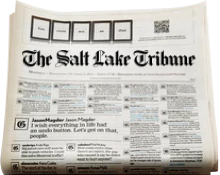This is an archived article that was published on sltrib.com in 2008, and information in the article may be outdated. It is provided only for personal research purposes and may not be reprinted.
Northern Utah's spikes of wintertime pollution landed two cities on an American Lung Association 10-worst list for dirty air.
Logan ranked sixth and Salt Lake City was seventh in the annual, nationwide air pollution review.
"The air quality in several cities has improved, but in others, declines in pollution have stalled," said the group's chief executive officer, Bernadette Toomey. "The trends tell us loud and clear that we need to do more to protect Americans from breathing air that's simply hazardous to their health."
Salt Lake City resident Dennis Kay was among those who welcomed the association's latest report, a review of three years' worth of air-pollution data.
"They are absolutely right," said Kay, an emphysema sufferer who fled the Wasatch Front during the high-pollution month of February. "It's an absolute shame."
The lung association, a health advocacy group based in Washington, D.C., called short-term particle pollution "a deadly cocktail of ash, soot, diesel exhaust, chemicals, metals and aerosols that can spike dangerously for hours to weeks on end."
The group noted that the body's natural defenses, such as coughing and sneezing, are unable to protect lungs from the microscopic particles, which are about one-fortieth the width of a human hair. The result can be difficulty breathing, asthma, heart attacks, strokes, lung cancer and premature death.
Kay blames lax state and federal regulation for allowing the air to become so polluted.
Like Kay, Bryce Bird of the Utah Division of Air Quality, welcomed the latest report. State regulators saw no surprises in the lung association's findings, but they took issue with some of the group's methods and overall conclusions for Utah.
"Their grades don't reflect the progress we've made," said Bird.
He noted that for the Cache Valley, for instance, more up-to-date data suggest voluntary measures have worked. Those measures include stepped-up public transit and a voluntary green-yellow-red air-quality action program.
He pointed to a D grade given to Washington County for its ozone levels as an example of misleading data. The grade was based on readings from an air monitor at Zion National Park that reflected poor air-quality during a series of wildfires in 2005, he said.
Federal regulations got tougher in late 2006. Yet, for the 2007-2008 winter pollution season, northern Utah had an unusually low number of bad air-quality days.
Good weather is largely responsible.
Northern Utah's basins trap pollution under several winter conditions - including high-pressure, snow cover on the ground and stagnant air. But an active weather pattern this past winter propelled a series of storm systems through northern Utah. As a result, the region experienced relatively few bad air days. Temperature inversions never got the chance to set up and settle in for extended periods.
The American Lung Association's latest report card on air pollution can be seen at http://www.lungusa.org. Here are some of the key national findings:
* One in 10 people lives in a place with unhealthful levels of ozone, short-term and year-round particle pollution.
* Two in five people live in counties where ozone or particle pollution reaches unhealthful levels.
* Unhealthful levels of ozone plague nearly one-third of Americans.
* More than one-quarter of Americans live where spikes of particle pollution are unhealthful, while one in six live where particle pollution makes the air unhealthful year-round.

